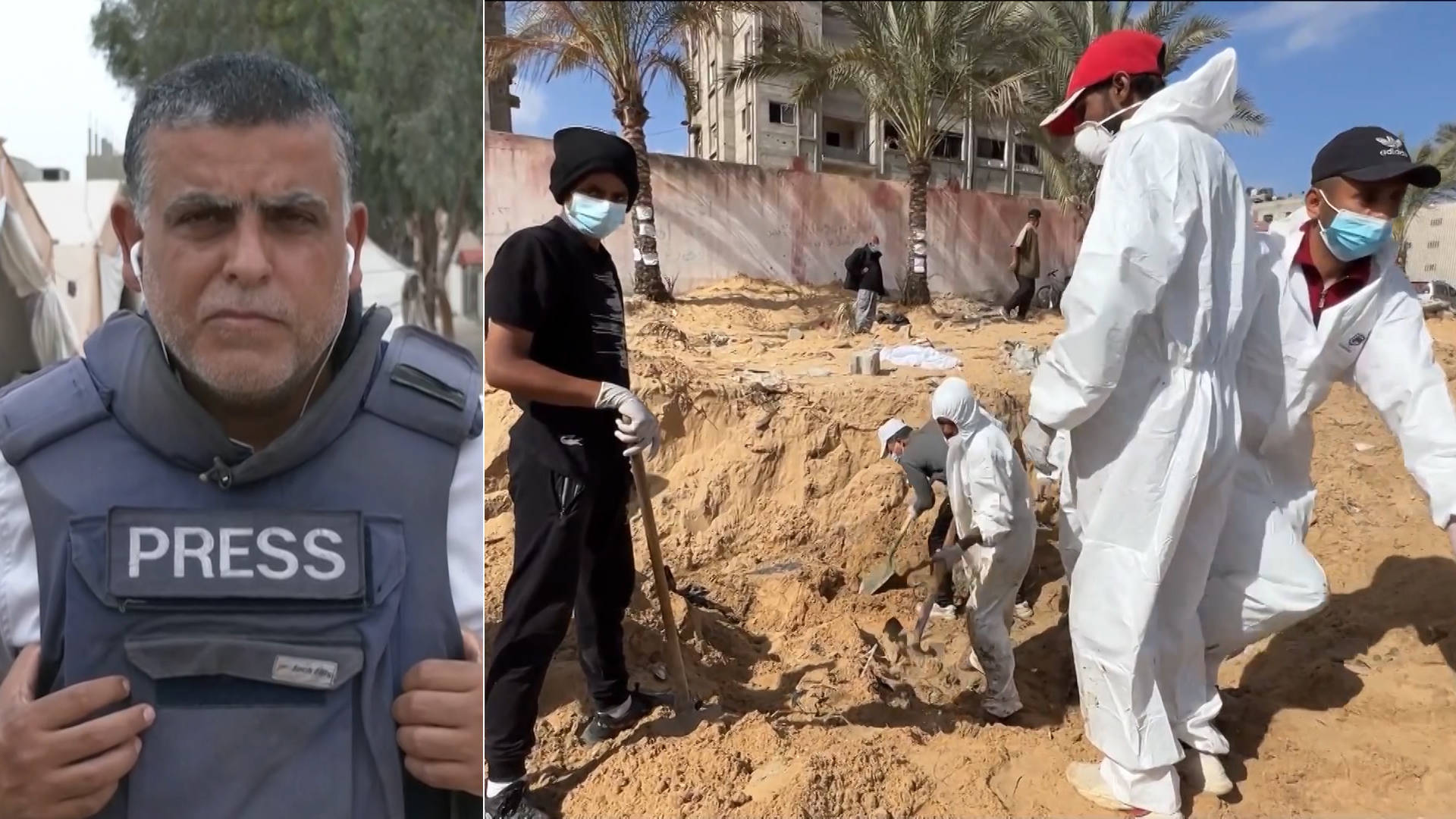This is a rush transcript. Copy may not be in its final form.
NERMEEN SHAIKH: In Gaza, medics and Civil Defense workers are still recovering bodies from mass graves found at the Nasser Medical Complex for the sixth day in a row following Israel’s siege on the hospital. Over 320 bodies have so far been discovered, including women, children, patients and medical staff, according to Al Jazeera. Another mass grave with up to 400 bodies was discovered weeks earlier at Al-Shifa Hospital in Gaza City. Civil Defense officials have said bodies were found stacked together and showed indications of field executions or being buried alive. The United Nations and the European Union have called for an independent probe into the mass graves, and the White House on Wednesday also called for an investigation.
This comes as Israel continues its bombardment of Gaza, with at least 43 people killed over the last 24 hours, according to the Palestinian Health Ministry. At least five of them were killed in the southern city of Rafah, where Israel has conducted near-daily airstrikes as it prepares for an offensive in the city.
AMY GOODMAN: A spokesperson for Prime Minister Benjamin Netanyahu’s government told Reuters Israel is moving ahead with a ground operation in Rafah, but gave no timeline. An unnamed Israeli defense official said Israel had bought 40,000 tents, each able to hold between 10 and 12 people, to house Palestinians evacuated from Rafah ahead of its assault on the city. Israeli news outlets report Israel will forcibly evacuate civilians to the nearby city of Khan Younis, which has been virtually destroyed by Israeli forces. Over 1.3 million Palestinians are seeking shelter in Rafah, the southernmost city in Gaza.
We go now to Rafah, in Gaza, where we’re joined by Akram al-Satarri, a journalist based in Gaza.
Welcome back to Democracy Now!, Akram. Just moments ago, Palestinian officials held a press conference in Rafah regarding the mass graves at the Nasser Medical Complex. Can you tell us the latest? I know there’s a delay in the broadcast.
AKRAM AL-SATARRI: Good morning, Amy, to you and all the viewers.
I have just come back from Khan Younis area. I was at Nasser Hospital. I spoke to the Civil Defense official who’s now giving this press conference about the situation in Nasser Hospital and about the number of the people who were killed, the way they were killed, and an account of the potential suffering they had been seeing even before they did.
It looks like the mass graves, the three different mass graves, are containing around 700 bodies. Up to this particular moment, around 400 bodies were unearthed and discovered. Around 300 bodies or even more are still in the ground. The bulldozer — one bulldozer, because of the very limited resources, working — is working there for the sake of just digging out the bodies.
Family members are lined up there. Family members are trying and rushing with passion and with great deal of sorrow to identify the bodies of their dears. Some of them managed to identify the bodies. Then you hear the outcry. You hear the people screaming, crying and mourning the death of their dears. But at the very same time, they feel a little bit relief, because they finally found the body of their dears.
I spoke to a mother who’s around 42, 43 years old. She was trying to identify her son. And then she found the body of her son. She was crying. The sister also, her daughter, was crying. And they were calling for the family to come and join them in the burial, because in our culture as Muslims and Arabs, we find a burial as the best fitting homage for the people who are dead.
People are continuously digging out the bodies. People are continuously — and this is very ironic — they’re trying to save the dead. People, when they die, are supposed to be resting in peace. And I was saying that people in Gaza, when they die, they’re neither resting nor in peace. The bodies, those bodies, were collected twice by the Israeli occupation forces. They were taken for some forensic investigation. They were returned to Nasser Hospital. They’re stockpiled in this very big hall, three different halls. And then they were buried. And then, a second time, the Israeli occupation forces came back to Nasser Hospital. They invaded all different departments of the hospital. They targeted the specialized surgery department, the reception and emergency. And they once again unearthed those hundreds of bodies and took them once again. And then they returned them to this mass grave or mass graves. So, the suffering even for the dead people in Gaza is still continuous.
And the heartache for their families is nonstop. Every single body that is being unearthed, you find tens of people rushing for the sake of identifying whether those are their relatives or otherwise. You see also many families looking into these individual graves in the Nasser Hospital area. You see written on the tombstone that “This guy is a tall guy. He has long hair. He’s wearing a gray shirt. And this is all we know.” And then it’s up to the family to try and to find and for people to recall what their dears were wearing the day they were parting from them, what were they wearing the day they were killed. So, a very emotionally draining process.
The numbers are quite shocking. But the account of the loss and the death that led to that eventual mass grave is extremely shocking, where some of the people — like you have just said, some of the people were tied. Some of the people had medical accessories on their hands, like the cannulas. And when they were unearthed from the ground, it was apparent that they were buried alive. Some people were tortured. Some of the bodies were extremely mutilated, which means that those bodies, some of their organs were taken by the Israeli occupation. Some lost their eyes. I could see some bodies with no eyes. I could see some bodies with no liver, with no kidney, some bodies that are — you see them, like the outer skin is just covering the skeleton, and that’s it. So, the account of that experience is quite heart-wrenching.
The families that have been suffering for the sake of just identifying their dears are also broken. They have been crying. But at least they say, “We feel comfortable because we found our dear.” So, it gives you an insight, a glimpse, into the suffering people of Gaza have been living. It gives you a glimpse into the bereavement the women, men, children and girls in Gaza have been experiencing for the last six months also.
NERMEEN SHAIKH: Akram al-Satarri, just for our audience to know, you know, whenever we speak to you, we have — there’s this constant noise around you, and those are drones, of course, flying overhead, as they have been for months now. But if you could respond? You know, the European Union, the United Nations and now also the United States have called for an independent investigation into these mass graves. So, your response to that? And we’re speaking to you in Rafah. If you could also describe what conditions there are on the ground?
AKRAM AL-SATARRI: Well, as to the independent scrutiny or investigation committee that needs to be developed, I’ve been working in journalism for around 16 years now. I have been hearing about the independent committees, commissions, inquiries, fact-finding committees and international reports and tribunals about the situation in Gaza, looking into the particular details of the incidents that were taking place, investigating the death of several people in mass killing incidents, including the war in 2008, the war in 2014 and the war in 2021. I have been hearing a book about Gaza and the war in Gaza from 2014, and I was reading the exact words that I’m going to say now: “Palestinians struggle to dig out the bodies.” So, this is something that happened in 2014. This is something that happened in 2008. This is something that happened in ’21, ’22 and is still happening throughout 2023 and 2024.
The international community has failed to preserve and — to preserve and observe the dictates of the international humanitarian law. The humanity at large is facing a challenge. All the political systems worldwide are asked now and expected to do something tangible for the sake of just saving the Gaza Strip. Rhetoric is no longer needed. Rhetoric is no longer satisfactory. We need them to do something tangible to stop the things that are happening in Gaza.
Some of the things that Gazans are suggesting, the no-fly zone to protect the civilians in Gaza. Some of the things that Gazans are suggesting, that Israel should be held accountable for what they call crimes that were committed against the humanity, against people, against civilians. The international humanitarian law is rich with terms and vocab that are related to the, what they call the civil objects, civil objects that are protected, journalists that are protected, medical teams that are supposed to be protected, medical facilities that are supposed also to be protected. But when you review the shocking numbers about the way that the journalists are being killed, for instance, the medical teams are being killed, for instance, you conclude that the international community is failing so far to do something tangible, rather than the statements, the condemnations, the calls for independent inquiries or commissions to look into the investigation. We need something tangible. And that something tangible has not been achieved so far. And Gazans have been dying constantly because of that.
Something should be done. Something swift should be done. Otherwise, the death would continue. Now in Gaza today, 79 people were killed. And an average number of around 65 to 79 is killed every day. And if nothing is done, this means the international community accepts the killing of Gazans and accepts the justification of Israel to continue that killing. [coughs] Sorry.
And when it comes to the situation in Rafah, in Rafah, around 1.4 to 1.2 million, because of the influx of people from Rafah in the last few days. People are so scared because of the looming ground operation. They understand that the Israeli occupation is going to target them, and they understand that death would be chasing them. So some of them moved from Rafah. Around 150,000 Gazans have already left Rafah and moved to the area in al-Mawasi, a buffer zone between Rafah and Khan Younis, in the hope that they would survive. The ones who are in Rafah and the ones who are in Khan Younis and the ones in Gaza, at the entirety of Gaza, are all IDPs, around 2.1 million IDPs, because of the destruction of the infrastructure, the destruction of the homes, the destruction of the streets, and because of the continuous bombardment that has been taking their life. And those people are living in areas that have no infrastructure. No infrastructure means that they don’t have water supplies that are regular. They don’t have sewage systems. They don’t have food. They don’t have even drinkable water with which they can cook the food. They don’t have houses. They’re living in tents. And today is a very hot day. Today and yesterday were very hot days in this specific season. And now people in the tents are struggling. They are sweating all day. The children that have respiratory — even the adults that have some respiratory disorders are suffering more than any other people, and this suffering is continuous.
And this situation, when it comes to the humanitarian situation in Gaza, is unbearable, unimaginable and unacceptable. When I tell you the situation is unimaginable, because, for me, some parts of Gaza and some part of those camps that I have seen, the suffering of the people is unimaginable. You will see them living just by the minimum, and even there is no minimum. And they have no other choice to continue living and waiting and hoping some solution would be developed or concluded sometime soon. This is the truth about the situation, something I have never seen in my life, let alone someone who’s living thousands of miles away from Gaza.
People are buried in the streets. People are buried on the pavement. People are buried everywhere, in their homes. And some of the bodies, around 10,000 bodies, are in Gaza, are still under the rubble, and they have not been retrieved so far. You walk down the streets, and you smell death everywhere. You go to the hospital, that is supposed to be the temple of protection and humanity, you find the hospital totally devastated by death. You find the patients, who were supposed to be receiving the medical treatments, buried within the hospital. And you smell their decomposed bodies after the bodies were desecrated and unearthed. And wherever you turn your face, you see the children, you see the adults, you see the women and the men, the girls and the boys, suffering from that unjust situation that is still continuous. And no one single international power could stop that or bring an end to that ongoing suffering and misery.
AMY GOODMAN: Akram al-Satarri, we want to thank you so much for being with us. Be safe. Akram is a Gaza-based journalist, speaking to us from Rafah.
This is Democracy Now! When we come back, we speak with the secretary general of Amnesty International, Agnès Callamard. Stay with us.











Post comments (0)